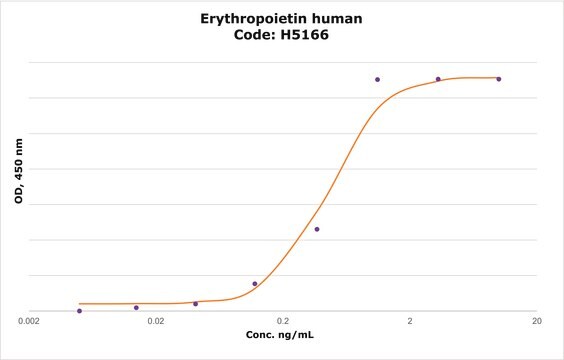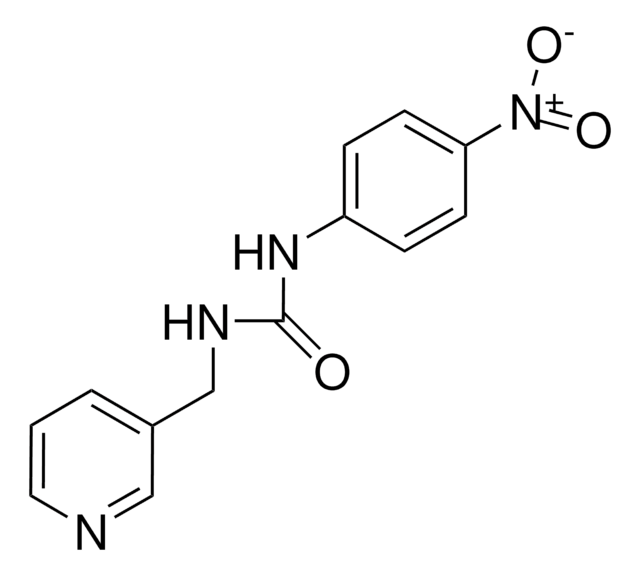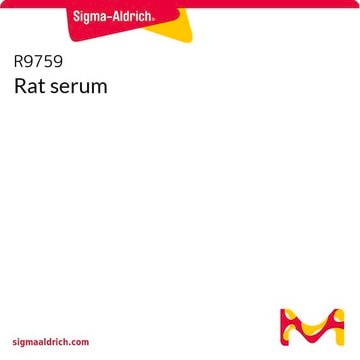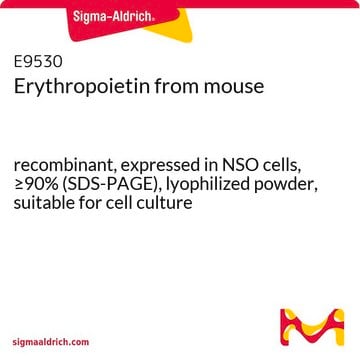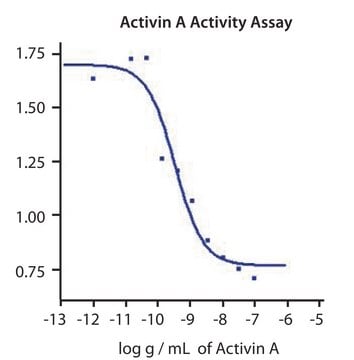E8905
Erythropoietin from rat
recombinant, expressed in insect cells, suitable for cell culture
Synonym(s):
EPO
Sign Into View Organizational & Contract Pricing
All Photos(1)
About This Item
Recommended Products
recombinant
expressed in insect cells
mol wt
22-26 kDa by SDS-PAGE
calculated mol wt 18.5 kDa
technique(s)
cell culture | mammalian: suitable
impurities
endotoxin, tested
storage temp.
−20°C
Related Categories
Biochem/physiol Actions
Erythropoietin, a glycoprotein produced primarily by the kidneys and at lower levels by the liver, is the primary regulatory factor of erythropoiesis. EPO promotes the proliferation, differentiation, and survival of the erythroid progenitors. EPO stimulates erythropoiesis by inducing growth and differentiation of burst forming units and colony forming units into mature red blood cells. EPO produced by kidney cells is increased in response to hypoxia or anemia.
The biological effects of erythropoietin are mediated by the erythropoietin receptor, which binds EPO with high affinity and is a potent EPO antagonist. When EPO is present at low concentrations, the EPO receptor initiates prolongation of G1 in the cell cycle and sends a differentiation signal; whereas at high EPO concentrations, a proliferation signal is generated and the G1 is shortened.
The biological effects of erythropoietin are mediated by the erythropoietin receptor, which binds EPO with high affinity and is a potent EPO antagonist. When EPO is present at low concentrations, the EPO receptor initiates prolongation of G1 in the cell cycle and sends a differentiation signal; whereas at high EPO concentrations, a proliferation signal is generated and the G1 is shortened.
Erythropoietin is a glycoprotein that is the principal regulator of red blood cell growth and differentiation.
Physical form
Lyophilized from a 0.2 μm filtered solution in phosphate buffered saline containing 0.5 mg bovine serum albumin.
Preparation Note
This Erythropoietin (EPO) is produced from a DNA sequence encoding rat erythropoietin (Met 1-Arg 192). Mature soluble recombinant rat EPO has Ala 27 at the amino terminus. The 166 amino acid residue soluble EPO has a calculated molecular mass of approximately 18.5 kDa. Due to glycosylation, the recombinant protein migrates as a 22-26 kDa in SDS-PAGE. Erythropoietin has been cloned from various species including human, murine, canine, etc. The mature proteins from the various species are highly conserved, exhibiting greater than 80% amino acid sequence identity. Rat EPO cDNA encodes a 192 amino acid residue precursor protein that is processed to yield a 166 amino acid residue mature protein. EPO contains 3 N-linked glycosylation sites. Glycosylation of EPO is required for the biological activities of EPO in vivo.
Analysis Note
The biological acitivity is measured by its ability to stimulate cell proliferation using TF-1 cell line.
Storage Class Code
11 - Combustible Solids
WGK
WGK 3
Flash Point(F)
Not applicable
Flash Point(C)
Not applicable
Personal Protective Equipment
dust mask type N95 (US), Eyeshields, Gloves
Certificates of Analysis (COA)
Search for Certificates of Analysis (COA) by entering the products Lot/Batch Number. Lot and Batch Numbers can be found on a product’s label following the words ‘Lot’ or ‘Batch’.
Already Own This Product?
Find documentation for the products that you have recently purchased in the Document Library.
Yueyue Yu et al.
PloS one, 8(7), e69620-e69620 (2013-08-13)
Neonatal necrotizing enterocolitis (NEC) is a devastating gastrointestinal disease of preterm infants. Increased intestinal epithelium permeability is an early event in NEC pathogenesis. Autophagy and apoptosis are induced by multiple stress pathways which may impact the intestinal barrier, and they
Ismayil Ahmet et al.
Biology open, 1(10), 1049-1053 (2012-12-06)
Activation of nitric oxide (NO) signaling is considered, at list partially, a mechanistic basis for EPO-induced cardioprotection. Surprisingly, hemodynamic response subsequent to NO activation after EPO administration has never been reported. The objectives of this study were to evaluate the
Nagao, M., et al.
Biochimica et Biophysica Acta, 117, 99-99 (1992)
Mikhail Lomonosov et al.
PloS one, 6(6), e21165-e21165 (2011-06-23)
Fbxo7 is an unusual F box protein that augments D-type cyclin complex formation with Cdk6, but not Cdk4 or Cdk2, and its over-expression has been demonstrated to transform immortalised fibroblasts in a Cdk6-dependent manner. Here we present new evidence in
Honghao Zhang et al.
Experimental and therapeutic medicine, 10(5), 1925-1930 (2015-12-08)
Chronic kidney disease (CKD) is commonly accompanied by inflammation and anemia; however, the pathogenesis of CKD is unclear. Expression of resistin, a cysteine-rich secretory plasma protein, is correlated with the expression of tumor necrosis factor (TNF)-α, interleukin (IL)-6 and lipoprotein-associated
Our team of scientists has experience in all areas of research including Life Science, Material Science, Chemical Synthesis, Chromatography, Analytical and many others.
Contact Technical Service